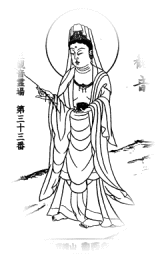
Sect: Shingon Sect Daikakuji School
Principal Deity: Enmei Jizo Bosatsu (Jizo Bodhisattva of Life Extension)
Founded: Around 780
Goeika (Sacred Chant): “As the evening falls, Will it sleep with the fading bloom, The drunken hibiscus, Embraced by the eternal smile of the Buddha.“
Emanation Form: Suisui Kannon (Water-Sprinkling Kannon)

The figure is characterized by holding a vessel in the left hand and a staff in the right. The vessel contains pure water, and the staff is dipped into it and sprinkled to cleanse the surrounding objects and purify our defilements and afflictions. It is said that this Kannon also saves us from the difficulties of water-related disasters, river pollution, and water shortages.
○ History & Origins
The temple was founded during the Nara period (around 780) by Gyoki Bosatsu. Originally located at the foot of Koshozan (about 1 km southwest of the current site), it was known as Koshoji. In the Heian period (around 800), Kobo Daishi rebuilt the temple and moved it to its current location, where it became the Imperial Temple under the patronage of Emperor Saga. In the Kamakura period (around 1200), the local feudal lord Kozai Sukemura rebuilt the temple’s halls under the command of the shogunate and renamed it Kozaiji, later relocating it about 500 meters east to its current location. During the Tensho period (around 1580), the temple was damaged by war, and during the Manji period (around 1660), it was again affected by a fire. The current structure is a part of what remained after the fires, and the temple’s Bishamonten statue (standing figure of the Buddhist god Bishamonten), dating from the early Heian period, is considered a national treasure due to its exceptional craftsmanship.
○ Message from the head priest
Let us join our hands in prayer with words like, “Thank you,” “I am sorry,” “Please be well,” and other heartfelt phrases. Gassho (palms together in prayer) is a gesture that symbolizes “the compassion of the Buddha.” With the Buddha on the right and ourselves on the left, let us join our hands with grace, offering a simple word of “Namu” (meaning “I take refuge in the Buddha”).
○ Access
Address: 211 Kozai Nishimachi, Takamatsu, Kagawa, 761-8015, Japan
Phone Number: 087-881-2337
Large Buses: Not permitted
Microbuses: Permitted
・Instagram:https://www.instagram.com/kouzaiji/